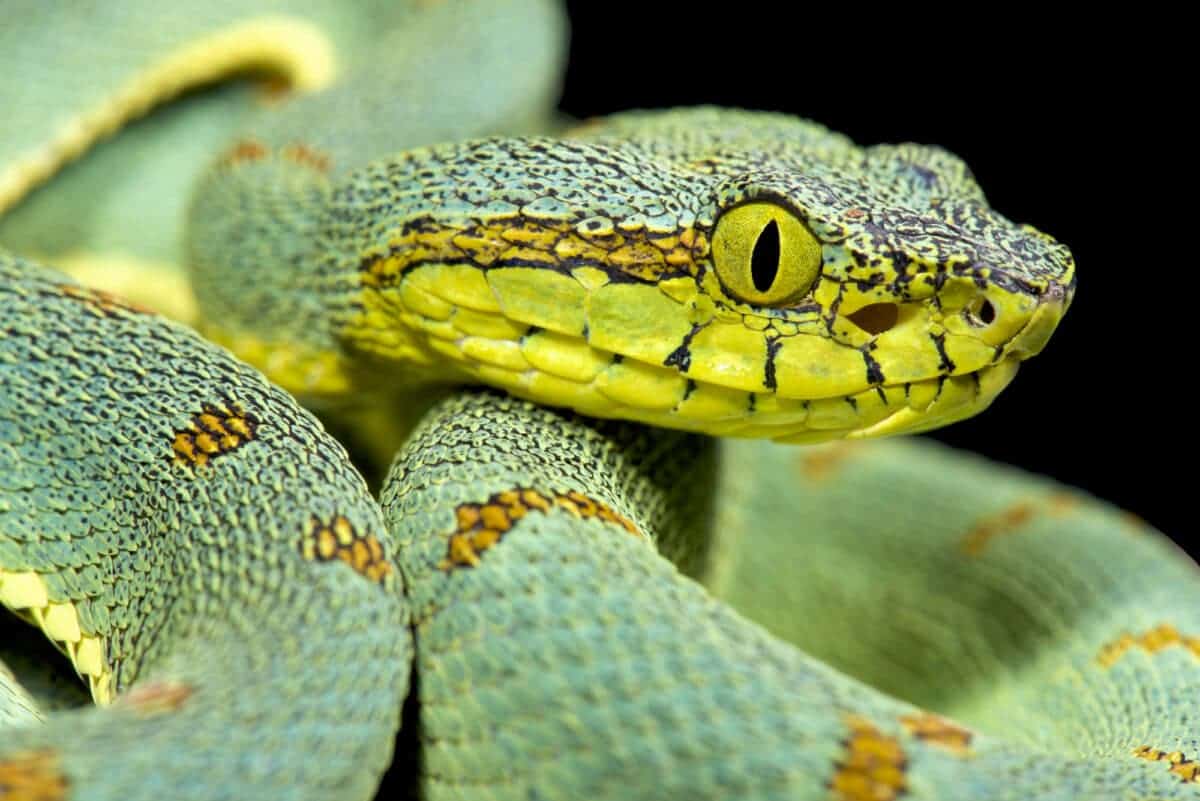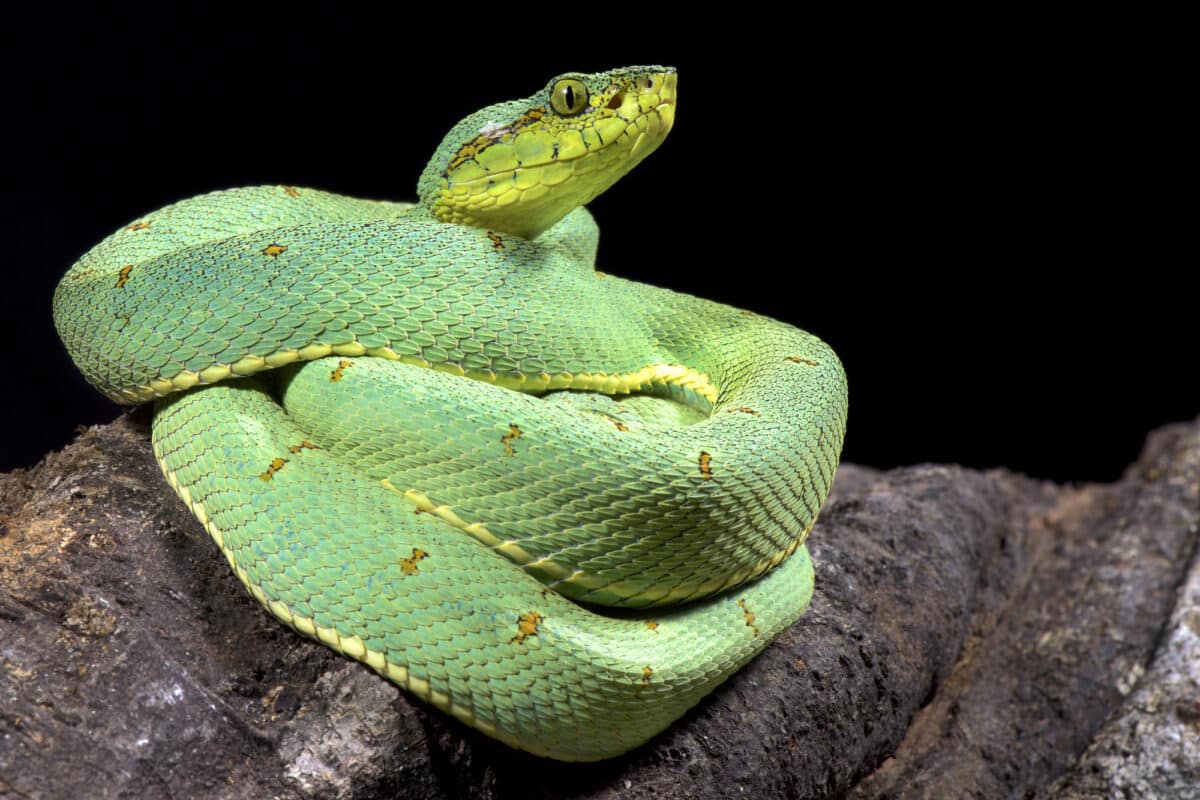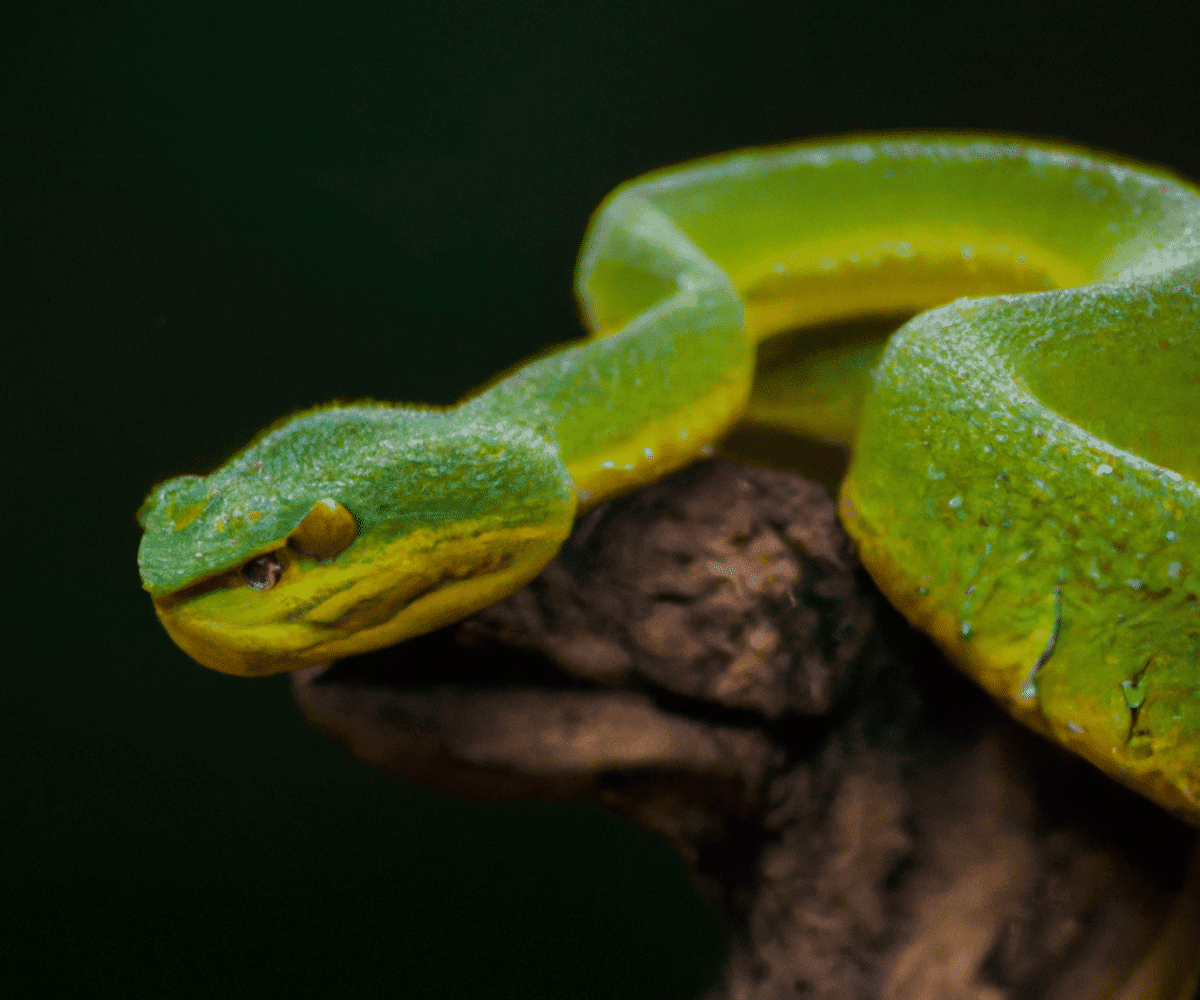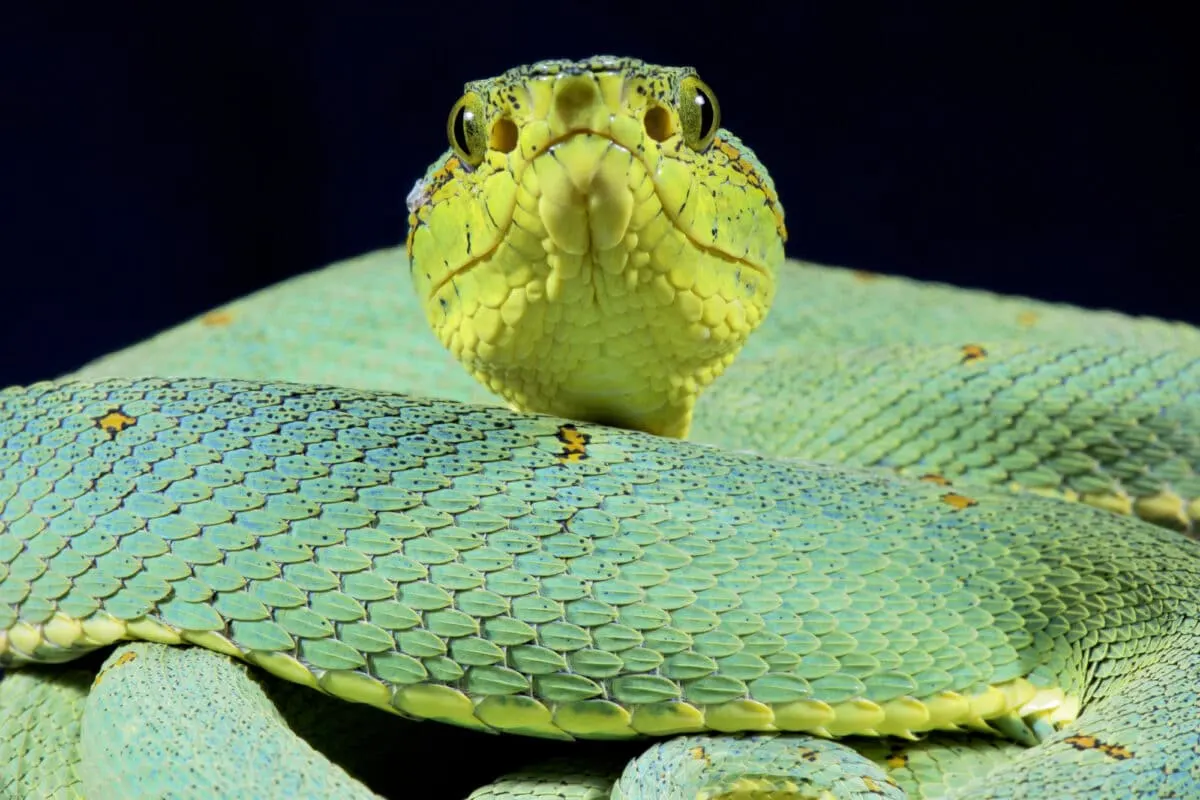Palm Pit Vipers are a species of venomous snakes commonly found in the tropical forests of South America and they can bite. Generally these snakes are known for their distinctive and striking appearance, with green and yellow scales that blend seamlessly into the surrounding foliage.
Despite their beauty, palm pit vipers are highly venomous, containing a potent mix of toxins that can cause severe medical complications in humans.
Want to jump ahead? Click below
Anatomy Of Palm Pit Vipers

A visually arresting species of venomous snake that may have negative medical effects are palm pit vipers. To identify these reptiles in the wild and comprehend the possible medical consequences of a bite, one must be aware of their anatomy.
- Physical Appearance And Characteristics
Palm pit vipers have a distinctive physical appearance that makes them easily recognizable. Generally these snakes have a green and yellow coloration that blends seamlessly into the surrounding foliage.
Their bodies are relatively small, typically measuring one to three feet long. Despite their small size, palm pit vipers are incredibly venomous and should be cautiously approached.
- Kinds Of Venom By Palm Pit Vipers
Humans should avoid contact with palm pit vipers’ highly toxic venom. Hemorrhagic, necrotoxic and neurotoxic toxins are among the strong mixture of toxins found in it. Humans may experience a range of health problems as a result of these toxins, from minor symptoms like localized pain and swelling to more serious and possibly fatal consequences like internal bleeding and organ failure.
It is noteworthy that the makeup of venom produced by palm pit vipers can differ based on the specific snake and its habitat. Moreover this implies that different snakes may have different effects from a bite.
- Significance Of Fangs In Venom Injection During Bites
When the Palm Pit Viper bites, its fangs work like hypodermic needles, injecting venom into the victim. Evidently the fangs of palm pit vipers are highly specialized. Moreover they have a grooved or hollow channel that allows venom to flow smoothly into the victim’s bloodstream. This means that even a small bite from a palm pit viper can deliver a potentially lethal dose of venom.
Want to compare with another viper? Let’s look at The Fer-De-Lance Pit Viper Bite.
Symptoms Of Palm Pit Viper Bite

The symptoms of a palm pit viper bite can differ based on the quantity of venom introduced and the location of the bite. Initially, being bitten by this snake can result in pain, swelling and redness in the bite area. Additional early indications may encompass feelings of dizziness, nausea, and weakness.
- Delayed Symptoms Of Envenomation
Evidently, delayed palm pit viper bite symptoms can occur hours or even days after the initial bite. These can be more severe, including bleeding from the gums, nose, or puncture wounds, significant swelling, pain, and even difficulty breathing.
- Severity And Duration Of Symptoms
Symptom intensity may differ according to the quantity of venom administered. While some individuals may encounter mild symptoms that resolve independently, a more severe bite can lead to substantial and potentially life-threatening complications.
Moreover without prompt medical intervention, symptoms can persist for several weeks. Thus leading to long-term issues like nerve damage, weakness and even paralysis. If bitten by a palm pit viper, it is imperative to seek immediate medical attention.
Medical Treatment For Palm Pit Viper Bite

Palm pit vipers are notorious for their extremely poisonous bites, which, if untreated, can cause serious health problems. Evidently the emergency procedures for palm pit viper bites are different medical interventions. Such as antivenom and the significance of timely and efficient treatment in averting serious medical complications are covered in this section.
Emergency Response Protocols For Palm Pit Viper Bites
In the unfortunate event that you become bitten by a palm pit viper, you should get medical help right away. Making a call to emergency medical services is the first step in getting the victim to the closest hospital. To stop the venom from spreading throughout the body while you wait for medical help, try to keep the affected limb immobile and below the level of your heart.
It is also vital to note that attempting to suck out the venom or apply ice, compression or incisions at the bite site can worsen the situation. Moreover these measures can cause a rapid release of venom into the bloodstream, leading to severe medical complications.
Antivenom And Other Medical Treatments For Palm Pit Viper Bites
Evidently antivenom is the primary treatment option for palm pit viper bites. Generally this medical intervention works by neutralizing the venom’s toxicity, preventing severe medical complications, and promoting the body’s natural healing process.
Moreover it is crucial to note that antivenom treatment can cause allergic reactions such as anaphylaxis. Therefore medical professionals must closely monitor patients receiving antivenom for adverse reactions.
For severe palm pit viper bites, additional medical interventions like painkillers, IV fluids and blood transfusions might also be required. Evidently medical practitioners must decide whether to use these treatments. Generally this is based on the patient’s individual medical needs.
Importance Of Prompt And Effective Treatment In Preventing Severe Medical Complications
Moreover in palm pit viper bites cases, the importance of seeking prompt medical attention and effective treatment cannot be overstated. The venom of these snakes can cause severe medical complications such as cardiovascular collapse, renal failure and respiratory distress.
Untreated palm pit viper bites can lead to permanent disability, amputation and death. Therefore, victims and medical professionals must recognize and act upon the urgency of treating palm pit viper bites as soon as possible.
Prevention And Safety Tips

Generally palm pit vipers are renowned for having an exquisite and remarkable appearance. This should not however, cause us to lose sight of the fact that they are extremely poisonous. Thus in order to prevent bites and guard against envenomation, the following tactics and safety measures can be implemented:
Strategies For Avoiding Palm Pit Viper Bites
Be aware of your surroundings and avoid areas where palm pit vipers are known to inhabit. These snakes prefer to live in tropical forests – especially in areas with beautiful foliage they can blend in.
- Wear appropriate clothing and footwear that covers your skin – especially when exploring jungle or forest terrains. Evidently this can reduce the chances of an accidental encounter with a palm pit viper.
- Use a stick or a long object to probe the ground before you, especially in areas with dense foliage, as palm pit vipers can be hard to spot.
- Do not touch, handle or provoke the snake, even if it appears docile. Palm pit vipers can strike in a split second and their venom can cause severe health complications.
Precautionary Measures To Protect Against Envenomation
- Firstly, if you encounter a palm pit viper, keep a safe distance and do not try to handle or capture it.
- Secondly, seek professional medical attention immediately if you suspect a snake has bitten you. Generally delaying medical treatment can worsen the effects of envenomation and potentially result in death.
- Thirdly, carry a snake bite first-aid kit when traveling in snake-infested areas. This should include a suction device, antihistamines, painkillers and bandages to immobilize the affected limb.
- Fourthly, always inform others of your location and itinerary, especially when traveling in remote or isolated areas, in case you need immediate assistance.
Importance Of Professional Guidance And Education On Palm Pit Viper Safety
Firstly seeking expert advice and education on palm pit viper safety is essential. Evidently this is particularly useful if you’re going somewhere where these snakes are frequently encountered. Furthermore, expert advice can offer insightful advice and useful pointers for preventing bites and preventing envenomation.
Take time to get familiarized with the local snake species and their habitat. Generally this can help you identify potential risks and know what to do in an encounter.
Educate yourself on the signs and symptoms of envenomation and how to respond in case of a bite. Moreover an early response can significantly reduce the severity of the effects.
If you are traveling with children, educate them on the risks and precautions associated with palm pit vipers. Children are usually more curious and may unknowingly put themselves at risk.
Key Points

| Palm pit vipers are a visually striking species of venomous snakes with potential medical consequences. |
| In palm pit viper bites cases, the importance of seeking prompt medical attention and effective treatment cannot be overstated. |
| The first step is to call for emergency medical services to transport the victim to the nearest hospital. |
| Carry a snake bite first-aid kit when traveling in snake-infested areas. This should include a suction device, antihistamines, painkillers and bandages to immobilize the affected limb. |
| Take time to get familiarized with the local snake species and their habitat. Generally this can help you identify potential risks and know what to do in an encounter. |
Wrapping Up with Palm Pit Viper Bite
Evidently palm pit vipers are both dangerous and fascinating animals. Thus they also demand respect and prudence. Seeking prompt medical attention after a bite is crucial in order to reduce the possibility of long-term health complications. In general, we can live in harmony with these snakes in their natural habitat if we are aware of their habits and traits and take the necessary safety measures.
Thanks for following along with me! I hope you enjoyed reading about these two entertaining animals.
Next up ~
Join our Forum for free today!

- Big Cats Love Mouthing Affection - July 22, 2024
- Kind Elephant Merciful To Lion Cubs - July 22, 2024
- Beachgoers Save Massive Shark Stranded In Florida - July 22, 2024


